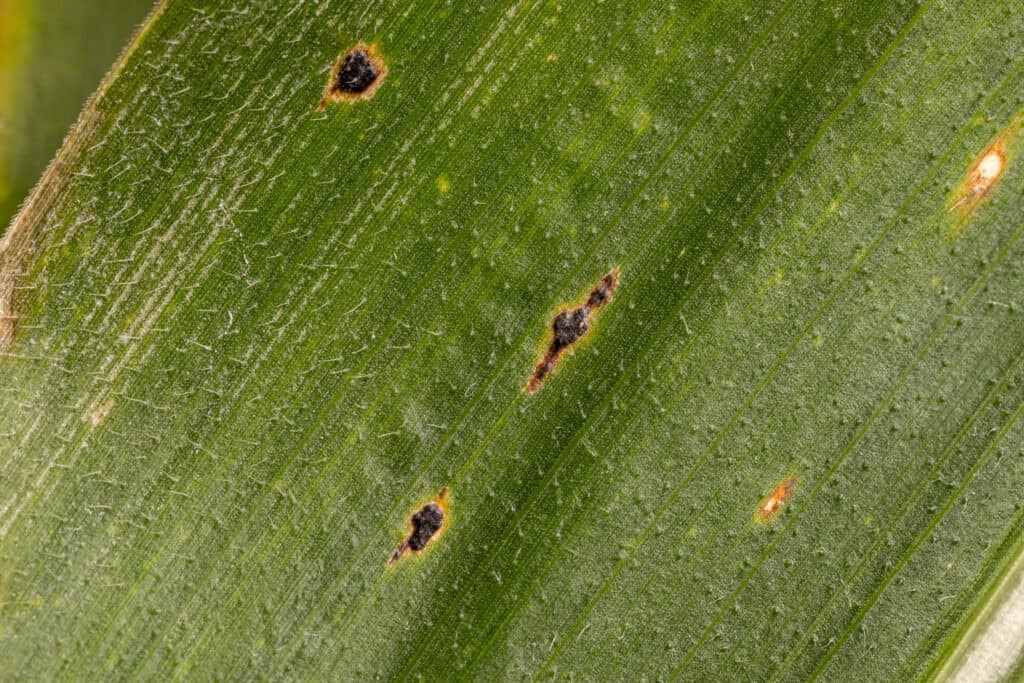Editor’s Note: Our blog article this week comes from a recent conversation with Dan Emmert, Lead Agronomist with Advanced Agrilytics in Southwest Indiana. He reports that due to a wide range of planting dates for this year’s corn crop, there is a tremendous variety of agronomic issues growers are facing right now. Here are some of his observations:
Even though April-planted corn is entering the dent stage, it still pays to get out and scout those fields to check on crop health and quality. What you observe will inform key decisions you make about next year’s crop.
“We’re helping our growers look at the environments and nutrient uptake mechanisms that are at work in their fields, observing how the management decisions we have helped them make are shaping the crop,” Emmert said. As we look at the roots, lower stalk and sucrose stores, we can see how the crop has responded to the management decisions we have made so far, then decide if any further actions are needed this year. These observations, in combination with additional data, give us a leg up on planning for next year.”
The Advanced Agrilytics field team is looking at crop progress, disease pressure, plant health, and other factors, and documenting how these field conditions might impact their customers’ crop management plants for 2025.
Meanwhile, for growers with late-planted corn, other threats are lurking in the fields…

Tar Spot on the Rise
According to Emmert, who supports our team in Southern Indiana and Kentucky, cases of Tar Spot have “really ramped up between U.S. 50 and I-70 during mid-July. We had rainstorms come through in mid-July, which gave us several days of rain. It’s not very hard to find stroma throughout this region.”
Stroma, or fungal stroma, is a dense mass of mycelium produced by certain pathogenic fungi, and it’s a common sign of Tar Spot in corn. Those tell-tale black tar-like spots on corn leaves are called stromata. Their presence in your field indicates a severe infection that can lead to reduced photosynthesis, weakened plants, and, ultimately, lower-quality corn and lower yields.
Late-Planted Corn More Susceptible
For a variety of reasons, late-planted corn can be more susceptible to fungal diseases such as Tar Spot:
- Tar Spot thrives in humid, wet conditions, so this increased wetness in July and August can create a more favorable environment for the disease to develop and spread.
- Late-season Vulnerability: Corn that is beginning to dent only has about 30 days of grain fill left, while a higher inoculum load and more humid wet weather favors Tar Spot development.
- More “Stressed-Out” Plants: Late-planted corn can face more stress than earlier-planted corn, such as heat stress or nutrient deficiencies. This can weaken the plants and make them more vulnerable to diseases such as Tar Spot.
What to Do Now
While early to mid-August can be a peak season for growers to consider a fungicide treatment, there are other agronomic factors to keep in mind. The timing of fungicide applications versus plant growth stage is critically important, according to Emmert.
“We want to protect the corn crop as far into the grain fill period as we can,” he explained. “Grain fill is approximately a six-week period, and a fungicide is going to provide about two to three weeks of disease protection, so we want to try and stop that Tar Spot for as long as we can into the dent stage of that plant’s growth.
“If the corn crop is near tasseling stage and there isn’t much disease pressure, we can consider holding that fungicide application until after pollination. When disease is low, waiting until the R2 stage to apply fungicide can extend our protection another 10 days into grain fill.”
Nitrogen Loss for Late-Planted Corn a Concern
For growers who applied a fall or spring pre-plant ammonia application, and then didn’t get corn planted until late May or even early June, nitrogen loss can be a concern. It’s a management concern now and can play a big part in influencing next year’s crop management decisions.
“For corn that is already pollinated, a rescue application of nitrogen could be difficult,” said Emmert. “But documenting these field conditions will play a part in informing our crop management decisions for next year.
“Fortunately, Advanced Agrilytics has unique, data-driven technology tools that allow us to break down the spatial environment of the sub-acre of each field. We can look at areas prone to nitrogen loss and see how much yield was lost in those saturated areas, and how to manage that environment more effectively next year. It may mean applying more nitrogen stabilizer in the wetter areas while lowering the rate on dry areas or adjusting their nitrogen timing.
“Our analytical methods let us look at a grower’s data in a much more granular way, compare it to what we see throughout the growing season, and then make precise, updated recommendations on how to continuously improve their management methods to get the most efficiency and productivity out of their acres.”
To learn more about how Advanced Agrilytics can increase yield consistency and provide more economic stability for your farming operation, fill out the form below.
Be proactive against Mother Nature
Connect with our agronomic experts to better understand how the unique attributes of your acre and our understanding of its mechanisms can provide insights for an already challenging year.